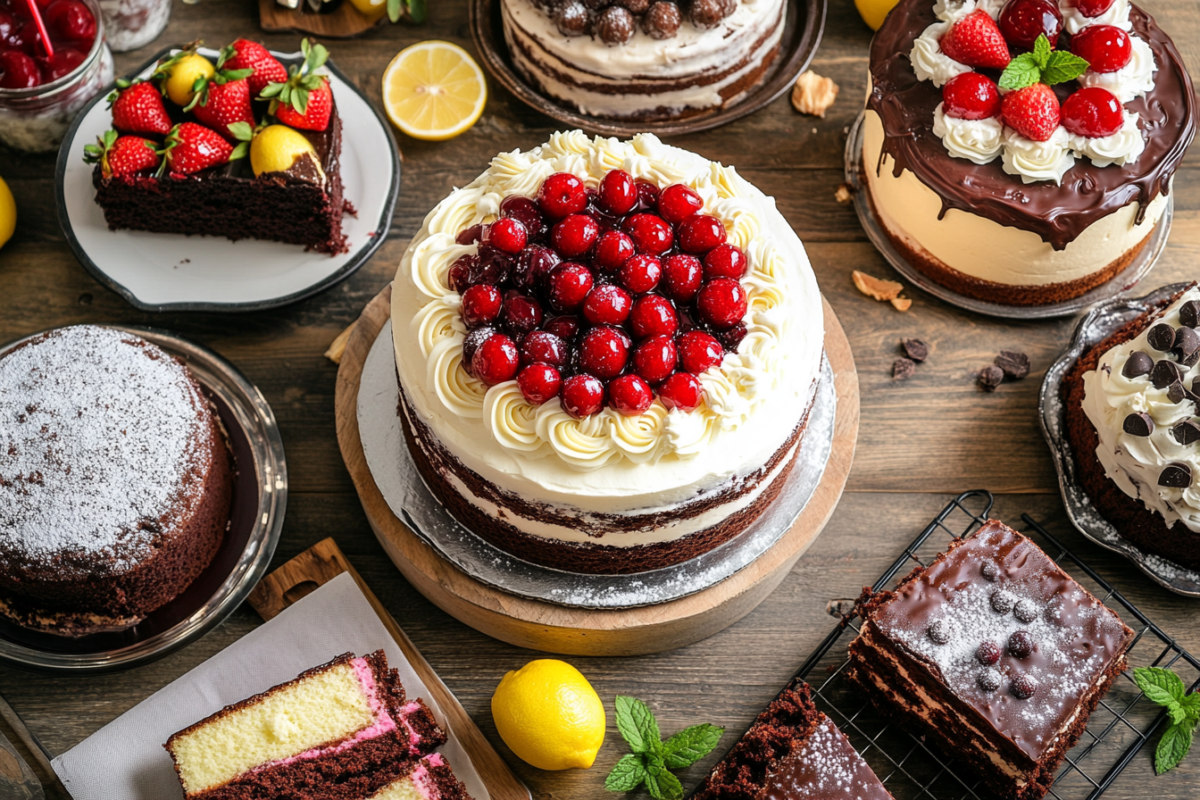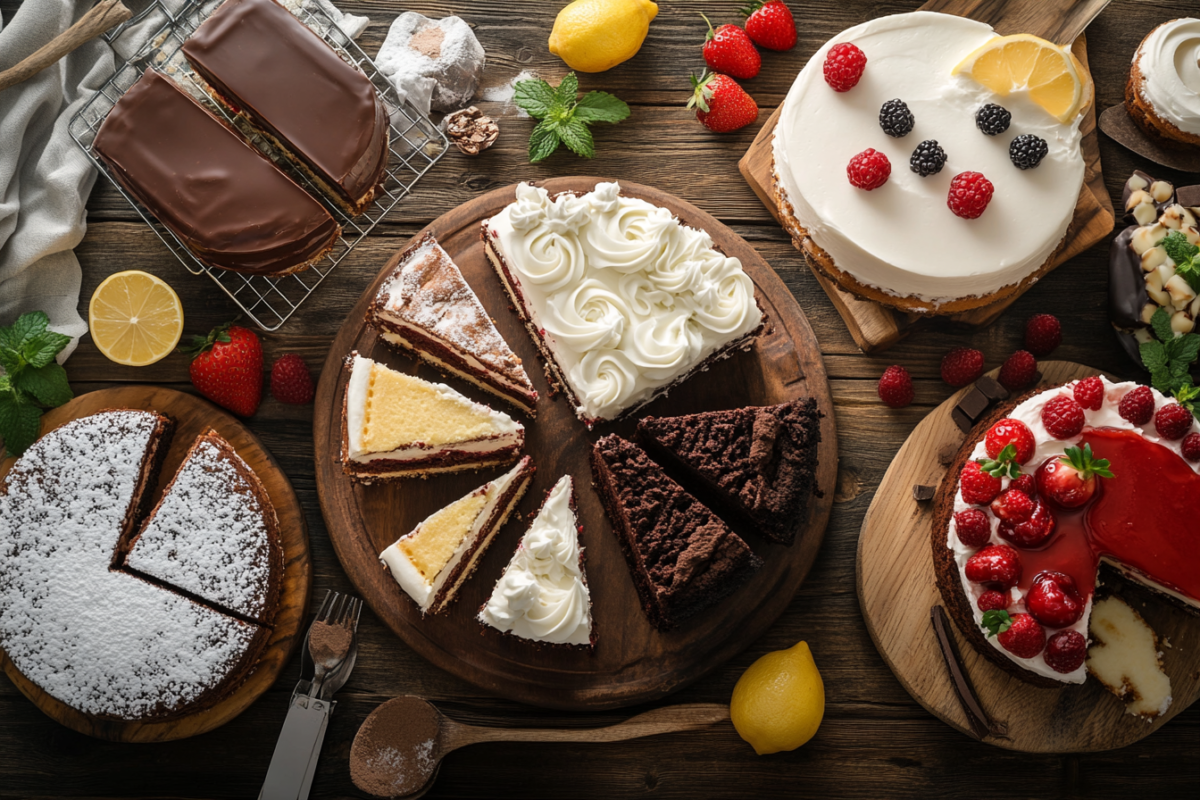Cakes have been a universal symbol of celebration, joy, and indulgence. From elaborate wedding cakes to simple sponge cakes baked at home, they are an irreplaceable treat that brings people together. This guide dives deep into the fascinating world of cakes, uncovering their types, flavors, baking techniques, and even their cultural significance. By the end, you’ll feel inspired to create your own masterpiece or appreciate the art behind every slice.
Introduction to Cakes
What Are Cakes?
Cakes are baked desserts made primarily from flour, sugar, eggs, and fat, often combined with leavening agents like baking powder to achieve a fluffy texture. They’re versatile, ranging from moist sponge cakes to dense flourless varieties. Cakes have evolved into a global culinary art form, loved by all ages.
The Rich History of Cakes
Did you know that cakes date back thousands of years? The earliest versions resembled bread sweetened with honey. As baking techniques advanced, so did the recipes, giving rise to the luxurious cakes we enjoy today. Countries worldwide have contributed their spin on this timeless dessert, from France’s Mille-feuille to Japan’s Castella cake.
Why Cakes Hold a Special Place in Celebrations
Whether it’s a birthday, wedding, or festive event, cakes are the showstopper. They’re not just a sweet treat but a way to express creativity, love, and hospitality. The ability to customize cakes makes them perfect for every occasion, big or small.
Types of Cakes
Cakes come in all shapes, textures, and flavors, making them one of the most versatile desserts. Let’s explore the main types of cakes, categorized by their preparation methods and key ingredients.
Sponge Cakes
Sponge cakes are light, airy, and perfectly fluffy, thanks to the eggs’ whipping process. These cakes rely on beaten eggs or egg whites as their primary leavening agent, giving them a delicate crumb.
Popular examples include the classic Victoria sponge, which layers jam and cream between soft sponge cakes, and the airy Genoise, often used in European desserts. Sponge cakes serve as the foundation for many decorated cakes, making them a baker’s favorite.
Their simplicity allows for endless variations—pair them with whipped cream, fresh fruits, or buttercream frosting to create a dessert that suits any occasion.
Butter Cakes
When it comes to rich, moist, and buttery textures, butter cakes steal the show. These cakes are made by creaming butter and sugar together before adding eggs and flour. The result? A denser yet tender crumb.
Yellow cake and pound cake are quintessential butter cakes, with the latter earning its name from its original recipe calling for a pound of each main ingredient. For those who crave bold flavors, butter cakes offer the perfect canvas to infuse vanilla, chocolate, or citrus zest.
They’re best served as standalone treats or layered with frosting for celebrations. Whether baked in a loaf pan or transformed into a layered masterpiece, butter cakes always delight.
Foam and Chiffon Cakes
Foam cakes, like Angel Food Cake, are fat-free and rely entirely on beaten egg whites for volume. This creates a delicate, cloud-like texture ideal for light desserts.
Chiffon cakes, on the other hand, incorporate oil and egg yolks, resulting in a moist yet fluffy cake. Their unique combination of airiness and richness makes them versatile for various occasions.
Both cakes are commonly flavored with vanilla, citrus, or almond, offering endless creative possibilities. Serve them with a dusting of powdered sugar or a drizzle of glaze for a sophisticated finish.
Flourless Cakes
Flourless cakes are proof that you don’t need flour to create a decadent dessert. These cakes are often made with alternative ingredients like almond flour, ground nuts, or even pure chocolate.
The most iconic example is the Flourless Chocolate Cake, celebrated for its dense, fudge-like texture and intense flavor. These cakes are naturally gluten-free, making them an excellent choice for those with dietary restrictions.
They shine at formal events, often served with a dollop of whipped cream or a berry compote. Whether you’re looking for a rich dessert or a health-conscious option, flourless cakes deliver indulgence without compromise.
Popular Cake Flavors and Variations
Cakes are beloved for their ability to embrace a plethora of flavors and styles. Each bite tells a story of creativity, cultural influence, and culinary expertise. Let’s delve into some of the most popular cake flavors and their regional variations that have captured hearts worldwide.
Chocolate Cakes
Few things can rival the indulgence of a rich chocolate cake. Whether it’s for a birthday party or an intimate gathering, chocolate desserts are a universal favorite. They come in countless variations, each offering a unique spin on this classic flavor.
The Black Forest Cake, a German masterpiece, combines layers of moist chocolate sponge, whipped cream, and cherries, topped with chocolate shavings. Its blend of tartness and sweetness makes it an elegant choice.
Molten Lava Cake, on the other hand, oozes sophistication—literally. With a gooey chocolate center that flows upon cutting, it’s a decadent dessert perfect for special occasions. Whether frosted or served warm with a scoop of ice cream, chocolate creations never fail to impress.
Vanilla and Fruit-Based Cakes
Vanilla desserts may seem simple, but their elegance lies in their versatility. These treats provide the perfect blank canvas for frostings, fillings, and toppings. Classic vanilla buttercream cakes, often adorned with sprinkles or fresh flowers, are timeless treats for celebrations.
Fruit-based cakes bring nature’s sweetness to the table. Strawberry Shortcake, with its layers of soft sponge, whipped cream, and fresh strawberries, is a summer favorite. Similarly, Lemon Drizzle Cake combines a tangy lemon flavor with a moist texture, thanks to the citrus-infused syrup poured over it.
These options strike a balance between sweetness and freshness, making them ideal for lighter, refreshing desserts.
Nut-Based Cakes
Nut-based creations are a celebration of earthy flavors and textures. Almond Cake, for instance, is a Mediterranean delight made with almond flour and often infused with orange or lemon zest. Its moist, dense crumb pairs beautifully with a dusting of powdered sugar or a drizzle of honey.
Walnut Cake is another classic, often accompanied by a creamy frosting or caramel glaze. Its rich, nutty flavor makes it a comforting dessert for colder months. These treats can also include other nuts like pistachios or pecans, offering endless variations.
Whether served plain or elaborately decorated, nut-based options bring a rustic charm to any table.
Specialty Cakes
Specialty creations go beyond traditional baking techniques to create unique desserts that stand out. Cheesecakes, for example, combine cream cheese, sugar, and eggs atop a buttery crust. Variations like New York-style cheesecake and Japanese fluffy cheesecake highlight the global appeal of this dessert.
Red Velvet Cake is another iconic specialty, known for its vibrant red hue and tangy cream cheese frosting. Its moist texture and mild cocoa flavor make it a striking centerpiece for any event.
Cake Baking Techniques and Tips
Baking isn’t just about mixing ingredients—it’s an art that requires the right tools, techniques, and a touch of patience. Whether you’re a seasoned baker or just starting out, understanding the essentials will set you on the path to creating the perfect dessert.
Essential Baking Tools
Mixing Bowls: Stainless steel or glass bowls are ideal for mixing batters. Measuring Tools: Use accurate measuring cups and spoons to ensure your proportions are spot-on. Stand or Hand Mixer: A mixer saves time and helps achieve a smooth batter or perfectly whipped frosting. Baking Pans: Keep a variety of sizes and shapes on hand, from round pans for layered desserts to loaf pans for pound cakes. Parchment Paper: Prevents sticking and ensures easy removal of your baked goods from the pan. Cooling Rack: Essential for letting creations cool evenly and avoiding soggy bottoms.
Investing in quality tools will make baking not only easier but also more enjoyable.
Common Baking Mistakes to Avoid
Overmixing the Batter: Too much mixing can develop gluten in the flour, leading to dense results. Mix just until ingredients are combined. Incorrect Oven Temperature: Always preheat your oven and use an oven thermometer to ensure accurate baking temperatures. Opening the Oven Door Too Often: Peeking can cause heat to escape, leading to uneven rising. Skipping the Cooling Step: Cutting into a dessert before it’s fully cooled can ruin its structure. Be patient and let it set on a cooling rack.
Decorating and Presentation
Decorating transforms creations from simple to spectacular. Whether it’s a birthday treat or a wedding centerpiece, presentation matters.
Basic Icing Techniques:
Crumb Coating: Apply a thin layer of frosting to seal in crumbs before adding the final coat. Piping: Use a piping bag and tips to create intricate designs, borders, or lettering. Smooth Finish: Use an offset spatula to achieve a polished look with buttercream or ganache.
Garnishing Ideas:
Edible Additions: Fresh fruits, sprinkles, or nuts add visual appeal and texture. Drips and Glazes: Drizzle chocolate or caramel glaze for a dramatic effect. Themed Decorations: For special occasions, add fondant shapes, edible flowers, or personalized toppers.
Cultural Significance of Cakes
Cakes have transcended their role as mere desserts to become powerful symbols of celebration, tradition, and unity. Across the globe, these delightful creations hold cultural significance, reflecting history, customs, and communal joy.
Cakes in Celebrations
No celebration feels complete without a cake at the center of the table. From birthdays to weddings, cakes symbolize milestones and shared happiness.
For birthdays, the act of blowing out candles atop a cake traces its origins to ancient Greece, where people offered round cakes to honor the moon goddess Artemis. Today, cakes are the highlight of birthday festivities, with countless designs and flavors tailored to the celebrant’s taste.
Weddings are another occasion where cakes take center stage. Elaborate multi-tiered wedding cakes are a tradition in Western cultures, symbolizing prosperity and the couple’s unity. In some regions, cutting the cake together is seen as a gesture of partnership and trust.
Even festivals like Christmas and Easter feature specialty desserts—think fruitcakes and Simnel cakes—adding a sweet touch to holiday gatherings.
Traditional Cakes Around the World
Every culture has its unique take on this delightful treat, reflecting local ingredients and traditions:
- Tiramisu: This Italian classic combines layers of coffee-soaked ladyfingers, mascarpone cream, and cocoa, embodying rich flavors and elegance.
- Tres Leches Cake: Popular in Latin America, this sponge cake soaked in three types of milk is a moist, indulgent dessert often served at family gatherings.
- Mooncakes: A staple during China’s Mid-Autumn Festival, these dense, round cakes are filled with lotus seed paste or red bean paste, symbolizing reunion and harmony.

Health Considerations and Alternatives
While desserts are undeniably delicious, it’s important to consider their health aspects—especially if you’re indulging regularly. Fortunately, there are plenty of healthier alternatives for those looking to enjoy desserts without compromising their health goals.
Nutritional Content of Desserts
Traditional recipes, though tasty, can be high in calories, sugar, and fat. For example, a standard slice of chocolate dessert with buttercream frosting can contain anywhere from 250 to 500 calories, depending on size and ingredients. Common ingredients like refined flour, butter, and sugar contribute to the dessert’s caloric content, while adding minimal nutritional value.
Though these treats can be a source of quick energy, overconsumption may lead to weight gain and an increased risk of heart disease due to their high sugar and fat content. It’s crucial to enjoy them in moderation to avoid the health pitfalls associated with sugary treats.
Healthier Dessert Options
For those who love these treats but are concerned about health, there are numerous alternatives:
Gluten-Free Options: Made with almond flour, coconut flour, or rice flour, gluten-free alternatives cater to those with gluten sensitivities or celiac disease. Vegan Alternatives: These omit eggs, dairy, and sometimes other animal-based products, replacing them with plant-based ingredients like flaxseed, almond milk, or coconut oil. Low-Sugar Treats: For those watching their sugar intake, low-sugar recipes use natural sweeteners like stevia, maple syrup, or mashed bananas. These alternatives reduce the overall sugar content without sacrificing flavor.
These healthier dessert options allow you to enjoy your favorite treat with a bit more peace of mind.
Frequently Asked Questions
About Desserts What are the different types of desserts?
There are many types of treats, including sponge varieties, butter-based recipes, foam creations, and flourless options. Each type differs based on ingredients and preparation methods, offering a variety of textures and flavors. Popular types include vanilla, chocolate, fruit-based, and nut-based options.
How do I make a moist dessert?
To make a moist result, it’s essential to use ingredients that retain moisture, such as buttermilk, yogurt, or oil. Additionally, avoid overmixing the batter, which can lead to a dry texture. Baking at the right temperature and not overbaking are crucial steps in ensuring a moist result.
What is the difference between sponge and butter recipes?
Sponge varieties are light and airy, relying on beaten eggs for leavening, while butter-based recipes are denser, thanks to the inclusion of butter, sugar, and eggs. Sponge options are ideal for layered desserts, whereas butter-based treats are more suitable for rich, indulgent dishes.
How can I substitute ingredients for dietary restrictions?
For gluten-free options, swap regular flour with almond flour or rice flour. For vegan recipes, use flaxseed or chia seeds as egg replacements, and plant-based milk like almond or oat milk. Low-sugar options can use natural sweeteners like stevia, honey, or maple syrup.
What are some popular dessert flavors?
Some popular flavors include chocolate, vanilla, red velvet, lemon, and carrot. Additionally, fruit-based options like strawberry shortcake or lemon drizzle offer a refreshing twist, while nut-based desserts, such as almond or walnut recipes, bring a hearty, earthy flavor.
Conclusion
These desserts have maintained their place at the heart of celebrations and gatherings for centuries, symbolizing joy, creativity, and community. From rich, decadent chocolate varieties to lighter sponge creations, the versatility of these sweet treats makes them a favorite across cultures. Whether you enjoy them as a simple treat or an elaborate centerpiece, there’s no denying the special role these desserts play in our lives.

